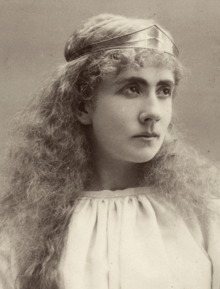Betty Hennings
Betty Mathilde Hennings née Schnell (1850–1939) was a Danish actress who entered the Royal Danish Theatre as a ballet dancer[1] but in 1870 turned to acting, first performing in Molière's The School for Wives. She later became known for her roles in the plays of Henrik Ibsen, especially as Nora in A Doll's House.[2][3]

Biography
Born on 26 October 1850 in Copenhagen, Betty Mathilde Schnell was the daughter of the tailor Stig Jørgen Schnell (1816–70) and Regine Sophie Dorothea Schmidt (1819–81). On 25 July 1877, she married the music publisher and composer Henrik Hennings.[4]
She trained as a ballet dancer at the Royal Danish Theatre under August Bournonville who recognized her talents, giving her leading roles including Hilde in A Folk Tale and promoting her to solo dancer in 1869. But her potential was also noticed by the dramatist Frederik Høedt who encouraged her to become an actress. She decided to accept his offer, preferring a more relaxed career on the stage to that of a ballet dancer.[4]
Her theatre début was in 1870 when she played Agnès in Molière's The School for Wives. As she matured, she began to perform in a number of Ibsen's plays, including Nora in A Doll's House, Hedvig in The Wild Duck, the title role in Hedda Gabler, and Ellida in The Lady from the Sea. She starred in other Scandinavian works, such as those by Bjørnstjerne Bjørnson, Holger Drachmann and Gunnar Heiberg but also performed in a variety of other dramas, including Shakespeare's Hamlet, playing Ophelia and later Gertrude, and as Schiller's Maria Stuart.[4]
In later life, Hennings continued to act in Ibsen's plays, taking on increasingly mature roles. One of her later roles was Clara in Gustav Wied's Skærmydsler. On her retirement in 1908, she was acclaimed as the first lady of the Royal Theatre.[5] All in all, she had played 170 parts in almost 3,000 performances.[3]
Betty Hennings died on 27 October 1939 in Gentofte.[4]
References
- Hans Christian Andersen; Knud Arne Jürgensen; August Bournonville (2005). Digterens & balletmesterens luner: H.C. Andersens og August Bournonvilles brevveksling. Gyldendal A/S. pp. 233–. ISBN 978-87-02-03751-7.
- Kvam, Kela. "Betty Hennings" (in Danish). Den Store Danske. Retrieved 7 June 2017.
- "Hennings, Betty Mathilde" (in Swedish). Nordisk familjebok. Retrieved 7 June 2017.
- Andersen, Elin. "Betty Hennings (1850 - 1939)" (in Danish). kvinfo. Retrieved 7 June 2017.
- Neiiendam, Robert. "Betty Hennings" (in Danish). Dansk Biografisk Leksikon. Retrieved 7 June 2017.
| Wikimedia Commons has media related to Betty Hennings. |